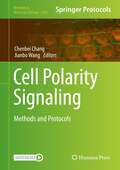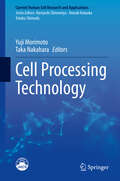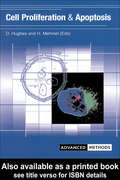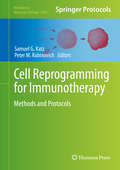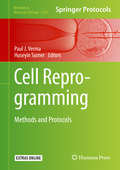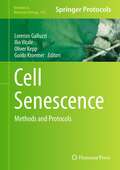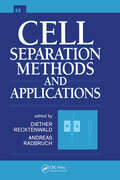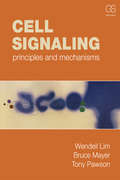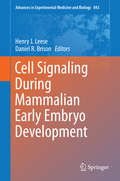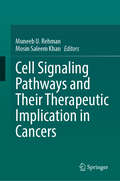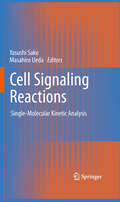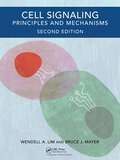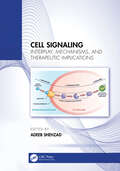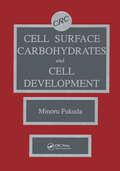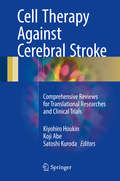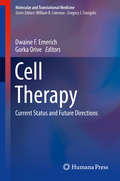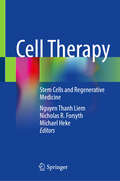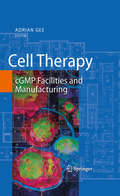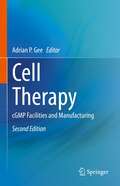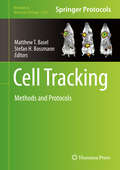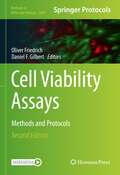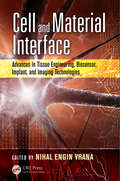- Table View
- List View
Cell Polarity Signaling: Methods and Protocols (Methods in Molecular Biology #2438)
by Jianbo Wang Chenbei ChangThis volume explores detailed methods to investigate various aspects of biology related to cell polarity, or asymmetry within a cell. Molecular, cellular, and tissue-level regulation and function as well as diseases caused by impairment of cell polarity are explored by these methods. Beginning with advanced imaging and biochemical methods, the book continues with planar cell polarity (PCP) signaling in morphogenesis in diverse developmental contexts, apicobasal (AB) cell polarity in development and diseases, as well as directional cell migration and biomechanics in cell polarity. The collection includes the usage of a wide variety of model systems and an extensive array of techniques, including genetic, imaging, biochemical, and biomechanical. Written for the highly successful Methods in Molecular Biology format, chapters include introductions to their respective topics, lists of the necessary materials and reagents, step-by-step, readily reproducible laboratory protocols, and tips on troubleshooting and avoiding known pitfalls. Authoritative and comprehensive, Cell Polarity Signaling: Methods and Protocols aims to enable researchers to delve into the stimulating field of cell polarity and contribute to our understanding of how coordinated control of protein stability, trafficking, membrane retention, post-translational modification, and dynamic organization leads to active regulation of cell polarity. Chapter 29 is available open access under a Creative Commons Attribution 4.0 International License via link.springer.com.
Cell Processing Technology (Current Human Cell Research and Applications)
by Yuji Morimoto Taka NakaharaAnimal cells have been used in a wide range of applications, from pharmaceuticals to regenerative medicine and cell therapy, as well as evaluating drugs and compounds. These applications are supported by cell processing technology, which refers to the process technology and quality control technology for aseptically culturing cells such as skin, cartilage, and bone cells in vitro and producing the result of cells or tissues. Cell Processing Technology provides the state of the art of cell-processing engineering, including new issues of efficient and automated culture technology of cells in transplantation and non-invasive cell quality assessment technology. The book will be of value to students and inexperienced engineers who are involved in drug discovery and cell medicine.
Cell Proliferation and Apoptosis (Advanced Methods)
by D. Hughes H. MehmetCell Proliferation and Apoptosis provides a detailed practical guide to cell proliferation and apoptosis detection methods. A novel approach combining both these areas allows important comparisons to be made. Topics covered include all aspects of tissue handling from collection, storage, fixation and processing through to locating and quantifying cells in different stages of the cell cycle. This book is an essential and comprehensive practical guide to these important and expanding areas.
Cell Reprogramming for Immunotherapy: Methods and Protocols (Methods in Molecular Biology #2097)
by Peter M. Rabinovich Samuel G. KatzThis volume details key protocols for developing strategies in immunotherapy. Chapters guide the readers through protocols related to various DNA, RNA and protein methods to reprogram the immune system, immune cells, analyzing the effect of the reprogrammed cells, and key methods to consider and analyze patients enrolled in clinical trials with novel immunotherapy regimens. Written in the highly successful Methods in Molecular Biology series format, chapters include introductions to their respective topics, lists of the necessary materials and reagents, step-by-step, readily reproducible laboratory protocols, and tips on troubleshooting and avoiding known pitfalls. Authoritative and cutting-edge, Cell Reprogramming for Immunotherapy: Methods and Protocols aims to ensure successful results in the further study of this vital field.
Cell Reprogramming: Methods and Protocols (Methods in Molecular Biology #1330)
by Paul J. Verma Huseyin SumerThis volume provides an understanding of the factors involved in nuclear reprogramming, which is essential for the success of reprogramming. The book is aimed at reprogramming differentiated cells and germ line transmission of pluripotent stem cells and features chapters that deal with reprogramming-related issues such as analysis of mitochondrial DNA in reprogrammed cells and the isolation of reprogramming intermediates; alternative methods for nuclear transfer; the production of germ-line chimeras from embryonic stem cells and induced pluripotent stem cells; and neonatal care and management of somatic cell nuclear transfer derived offspring. Written in the highly successful Methods in Molecular Biology series format, chapters include introductions to their respective topics, lists of the necessary materials and reagents, step-by-step, readily reproducible laboratory protocols and tips on troubleshooting and avoiding known pitfalls. Authoritative and cutting-edge, is the perfect guide for molecular biologists, stem cell biologists, clinicians, biotechnologists, students, veterinarians and animal care technicians involved with reprogramming, nuclear transfer and transgenesis.
Cell Senescence: Methods and Protocols (Methods in Molecular Biology #965)
by Ilio Vitale Oliver Kepp Guido Kroemer Lorenzo GalluzziCell senescence is the process whereby cells permanently lose the possibility to proliferate without undergoing cell death, and occurs in a plethora of distinct model organisms. In Cell Senescence: Methods and Protocols, expert researchers in the field detail the methods that are now commonly used to study cell senescence, in model organisms encompassing bacteria, fungi, worms, flies, zebrafish, and mammalian cells. These techniques cover the study of all the morphological, biochemical and functional manifestations of senescence at the cellular level and include protocols for population analyses and high-throughput approaches in suitable model organisms. Written in the highly successful Methods in Molecular BiologyTM series format, chapters include introductions to their respective topics, lists of the necessary materials and reagents, step-by-step, readily reproducible laboratory protocols, and key tips on troubleshooting and avoiding known pitfalls.
Cell Separation Methods and Applications
by Andreas Radbruch Diether Recktenwald"Offers complete coverage and assessment of cell separation technologies for analytical and preparative isolations of biological cell populations-demonstrating how to select and devise optimal sorting strategies for applications in biochemistry, immunology, cell and molecular biology, and clinical research. "
Cell Signaling
by Wendell Lim Bruce Mayer Tony PawsonCell Signaling presents the principles and components that underlie all known signaling mechanisms. The book provides undergraduate and graduate biology students with the tools needed to make sense of the array of specific pathways used by the cell to communicate. It describes basic signaling mechanisms such as protein interactions, changes in enzyme activity, post-translational modifications, subcellular localization of signaling molecules, and small diffusible signaling mediators. The book also explores the components of signaling pathways and how they are wired into pathways and circuits that can process information.
Cell Signaling During Mammalian Early Embryo Development (Advances in Experimental Medicine and Biology #843)
by Henry J. Leese Daniel R. BrisonThe book considers signaling events from the zygote embryo through to the blastocyst with relevant data from embryonic stem (ES) cells, including dialogue with the extracellular environment and with the maternal tract during the implantation process. Application of the knowledge described to improve the success of human and animal assisted conception is considered where appropriate, but the focus is largely on fundamental rather than applied cell/molecular biology, as this is the area that has historically been neglected. While the general features of metabolism during preimplantation development are well established, especially in terms of nutrient requirements, uptake and fate, remarkably little is known about early embryo signaling events, intracellular or intercellular, between individual embryos in vitro or with the female reproductive tract in vivo. This contrasts with the wealth of information on cell signaling in somatic cells and tissues, as a glance at any textbook of biochemistry illustrates. This lack of information is such that our understanding of the molecular cell biology of early embryos -- a prerequisite to defining the mechanisms which regulate development at this critical stage of the life cycle -- is seriously incomplete. This volume is the first to address this issue by describing the current state of knowledge on cell signaling during mammalian early embryo development and highlighting priority areas for research.
Cell Signaling Pathways and Their Therapeutic Implication in Cancers
by Muneeb U. Rehman Mosin Saleem KhanThis book discusses different signaling pathways involved in tumor development and progression. It discusses the pathways that allow tumor cells to proliferate, survive, and invade other tissues. Further, the book reviews the signal transduction regulating phagocytosis, production of cytokines, cell division, and differentiation. It elucidates the dysregulation of cellular signal transduction induced by the genetic and epigenetic changes that drive cancer and enumerates the signaling network encompassing the extracellular matrix, blood vessels, and the immune system. Additionally, the book provides mechanistic insights into inhibitors of the receptor tyrosine kinases, BRAF, EGFR, and ALK that improve clinical response and increase the survival of patients with cancer. The book covers the signal transduction pathways that regulate cell cycle progression and genomic stability, providing a mechanistic understanding of the major checkpoint pathways, and reviewing their diagnostic and therapeutic potential. This volume is essential reading for researchers to understand the therapeutic potential of important signaling molecules against cancer.
Cell Signaling Reactions: Single-Molecular Kinetic Analysis
by Masahiro Ueda Yasushi SakoThis book encompasses the exciting developments and challenges in the fast-moving and rapidly expanding research field of single-molecule kinetic analysis of cell signaling that promises to be one of the most significant and exciting areas of biological research for the foreseeable future. Cell signaling is carried out by complicated reaction networks of macromolecules, and single-molecule analyses has already demonstrated its power to unravel complex reaction dynamics in purified systems. To date, most of the published research in the field of single-molecule processes in cells, focus on the dynamic properties (translational movements of the centre of mass) of biological molecules. However, we hope that this book presents as many kinetic analyses of cell signaling as possible. Although single-molecule kinetic analysis of cellular systems is a relatively young field when compared with the analysis of single-molecule movements in cells, this type of analysis is highly important because it directly relates to the molecular functions that control cellular behavior and in the future, single-molecule kinetic analysis will be largely directed towards cellular systems. Thus, we hope that this book will be of interest to all those working in the fields of molecular and cell biology, as well as biophysics and biochemistry.
Cell Signaling, 2nd edition: Principles and Mechanisms
by Wendell A. Lim Bruce J. MayerCell Signaling provides undergraduate and graduate students with the conceptual tools needed to make sense of the dizzying array of pathways that cells use to detect, process, and respond to signals from the environment. By emphasizing the common design principles and molecular processes that underlie all signaling mechanisms, the book develops a broad conceptual framework through which students can understand diverse signaling pathways and networks. The book first examines the common currencies of cellular information processing and the core components of the signaling machinery. It then shows how these individual components link together into networks and pathways to perform more sophisticated tasks. Many specific examples are provided throughout to illustrate common principles, and to provide a comprehensive overview of major signaling pathways.Thoroughly revised, this second edition includes two new chapters and substantial updates to the text and figures throughout the book.Key features: The book provides a conceptual framework through which all signaling pathways can be understood without memorization of details It is extensively illustrated, including high-quality diagrams and schematics to elucidate important concepts and processes Each chapter concludes with a useful summary section that brings together the key concepts End-of-chapter review questions test the reader’s understanding of the material covered Two new chapters have been written especially for this edition: "Signaling and Disease" and "Diversity in Signaling across Phylogeny"
Cell Signaling: Interplay, Mechanisms, and Therapeutic Implications
by Adeeb ShehzadThis book provides a comprehensive understanding of cell signaling, molecular interactions, and their implications for human health and diseases. It introduces fundamental principles underlying cell communication through signaling molecules and their diverse transmission and reception mechanisms, highlighting their role in intercellular communication through voltage- and ion-gated channels, immunological and neuron synapses, and rhinovirus–receptor interaction involved in pathogenesis and disease development. Toward the end, the book highlights the profound implications of altered cell signaling pathways in the inflammation and immune response followed by the progression of various disorders, including cancer, endocrine disorders, and neurological illnesses. It explores the diagnostic and therapeutic implications of cell signaling in targeted therapies, highlighting advanced techniques for detecting signaling molecules and innovative therapeutic approaches to inspire new developments in precision medicine. It serves as an important resource for academics, students, and professionals in the fields of cell biology and biomedical sciences.Key Features: Provides in-depth understanding of cell signaling, exploring its complexities and impact on human health and disease Introduces fundamental principles of cell communication, emphasizing the different signaling molecules and their various transmission pathways Focuses on complex structures and functions of receptors, highlighting their essential role in intercellular communication and regulating cellular behavior Examines the molecular aspects of cell surface adhesion receptors, elucidating protein–protein interactions, signaling cascades, and enzyme–substrate interactions Discusses the impact of cell signaling on inflammation, cancer, and endocrine and neurological disorders
Cell Surface Carbohydrates and Cell Development
by Minoru FukudaCell Surface Carbohydrates and Cell Development summarizes knowledge on the structure and function of cell surface carbohydrates in development and differentiation. The chapters include reviews on the expression of cell type-specific carbohydrates and their roles in cell-cell interaction. In particular, the role of cell surface carbohydrates in immune cell response, malignant transformation, fertilization, and neural cell development are addressed. This includes the exciting discovery about the role of adhesive molecules in leukocyte-endothellium interaction.Cell Surface Carbohydrates and Cell Development also summarizes the latest knowledge on structure and biosynthesis of carbohydrates, the role of specific carbohydrate modification, and animal lectins. The book will be useful to researchers and students interested in the biology of glycoproteins and biotechnology.
Cell Therapy Against Cerebral Stroke: Comprehensive Reviews for Translational Researches and Clinical Trials
by Kiyohiro Houkin Koji Abe Satoshi KurodaThis book presents comprehensive reviews for both translational research and clinical trials on cell therapy for stroke. Cerebral stroke is still a leading cause of death and disability. However, despite intensive research, few treatment options are available. The therapeutic potential of cell transplantation has been studied for various pathological conditions of the central nervous system (CNS) including traumatic brain injury, traumatic spinal cord injury, degenerative disease, demyelinating disease and ischemic stroke, as the injured neural tissue in the CNS has only a limited regenerative capacity. Recently, a growing body of evidence in this field suggests that cell transplantation holds great potential as a form of stroke therapy. The authors, who are experts in the field of neurosurgery, review and discuss optimal cell sources and various issues involved in translational research; further, they outline ongoing clinical trials in Japan.
Cell Therapy for Brain Injury
by David C. HessCell Therapy for Brain Injury is a thorough examination of using state-of-the-art cell therapy in the treatment of strokes and other traumatic brain injuries. This invaluable book covers this niche topic in depth from basic stem cell biology and principles of cell therapy through proposed mechanisms of action of cell therapy in stroke, pre-clinical data in stroke models, ongoing clinical trials, imaging and tracking of cells with MRI, neural stem cells in stroke and the "big pharma" perspective of cell therapy. Each chapter is written by well-known leaders in each field, thus providing a wealth of expertise. The breadth of this book makes it essential reading for neuroscientists, stem cell biologists, researchers or clinical trialists at pharmaceutical or biotechnology companies. It also serves as a thorough introduction for graduate students or post-doctoral fellows who hope to work in these fields.
Cell Therapy: Current Status and Future Directions (Molecular and Translational Medicine)
by Dwaine F. Emerich Gorka OriveThis volume provides a comprehensive, state-of-the art review of the field of cell therapy. The volume begins with an overview of the breadth of the field and then turns to overviews of imaging technologies that can aid in both safety and efficacy evaluations. The book then turns to numerous contributions detailing the rapidly growing field of stem cell therapies. These sections cover our understanding of the natural roles of stem cells in biology and human disease and then touches on several of the more prominent areas where stem cells are moving rapidly into clinical evaluation including neurodegenerative diseases, muscular dystrophy, cardiac repair, and diabetes. The volume concludes with contributions from experts in oncology, ophthalmology, stem cells, 3-D printing, and biomaterials where the convergence of expertise is leading to unprecedented insights into how to minutely control the in vivo fate and function of transplanted and/or endogeneously mobilized cells. Finally, the book provides insights into the pivotal relationship between academic and industrial partnerships. This volume is designed to touch on the major areas where the field will make its greatest and most immediate clinical impacts. This text will provide a useful resource for physicians and researchers interested in the rapidly changing filed of cell therapy.
Cell Therapy: Stem Cells and Regenerative Medicine
by Nguyen Thanh Liem Nicholas R. Forsyth Michael HekeThis book provides an overview of cell-based therapy for human diseases including the definition, history, and clinical applications of human stem cells and their use in regenerative medicine. It covers human pluripotent stem cells (human embryonic stem cells and human induced pluripotent stem cells), mesenchymal stem/stromal cells, and hematopoietic stem cells, bone marrow mononuclear cells. In terms of clinical applications, this book also provides an update on recent human trials using these cells to treat various diseases, including neurological disorders, pulmonary dysfunctions, metabolic/endocrine-related diseases, frailty, and cancer treatment. In addition, it discusses the authors’ clinical trial experiences related to these conditions in a clinical setting to provide additional insight into regenerative medicine, especially cell-based therapy. The field of regenerative medicine has witnessed tremendous advancement in stem cell research and therapy in recent years, with thousands of preclinical studies supporting thousands of human clinical trials conducted worldwide. Emerging evidence in regenerative medicine and stem cell research suggests the treatments are safe, whereas their therapeutic potential, effectiveness, and mode of action require deeper investigation. It is important to introduce the science behind stem cell-based therapy to patients, clinicians, and researchers to further enhance understanding of responsible clinical conduct and so to educate and thus prevent the further emergence of unregulated, deceitful stem cell clinics solely operating for the sake of profit.
Cell Therapy: cGMP Facilities and Manufacturing
by Adrian GeeCell Therapy: cGMP Facilities and Manufacturing is the source for a complete discussion of facility design and operation with practical approaches to a variety of day-to-day activities, such as staff training and competency, cleaning procedures, and environmental monitoring. This in-depth book also includes detailed reviews of quality, the framework of regulations, and professional standards. It meets a previously unmet need for a thorough facility-focused resource, Cell Therapy: cGMP Facilities and Manufacturing will be an important addition to the cell therapy professional's library. Additional topics in Cell Therapy: cGMP Facilities and Manufacturing...Standard operating procedures - Supply management - Facility equipment - Product manufacturing, review, release and administration - Facility master file.
Cell Therapy: cGMP Facilities and Manufacturing
by Adrian P. GeeThis new edition presents a fully-updated and expanded look at current Good Manufacturing Practice (cGMP) for cell therapy products. It provides a complete discussion of facility design and operation including details specific to cord blood banking, cell processing, vector production and qualification of a new facility. Several chapters cover facility infrastructure including cleaning and maintenance, vendor qualification, writing a Standard Operating Procedure, staff training, and process validation. The detailed and invaluable product information covers topics like labelling, release and administration, transportation and shipment, et al. Further chapters cover relevant topics like writing and maintaining investigational new drug applications, support opportunities in North America and the European Union, commercial cell processing and quality testing services, and financial considerations for academic GMP facilities. A chapter on future directions rounds out Cell Therapy: cGMP Facilities and Manufacturing making it essential reading for any cell therapy professional involved in the development, use, or management of this type of facility.
Cell Tracking: Methods and Protocols (Methods in Molecular Biology #2126)
by Matthew T. Basel Stefan H. BossmannThis volume details methods used to track cells in the body and will serve as a reference for preclinical and clinical researchers in the fields of medicine and biomedical science. Chapters guide readers through protocols on bioluminescence imaging, fluorescence imaging, magnetic resonance imaging (MRI), ultrasound, computed tomography, and positron emission spectroscopy. Written in the highly successful Methods in Molecular Biology series format, chapters include introductions to their respective topics, lists of the necessary materials and reagents, step-by-step, readily reproducible laboratory protocols, and tips on troubleshooting and avoiding known pitfalls. Authoritative and cutting-edge, Cell Tracking: Methods and Protocols aims to ensure successful results in the further study of this vital field.
Cell Viability Assays: Methods and Protocols (Methods in Molecular Biology #1601)
by Daniel F. Gilbert Oliver FriedrichThis volume provides an overview of commonly used methods and protocols for cell fitness indicators. Chapters detail biochemical, fluorescence and luminescence-based strategies, computational, and label-free methodologies for assaying cellular viability by means of e. g. viscoelastic properties, impedance and multiphoton microscopy. Written in the highly successful Methods in Molecular Biology series format, chapters include introductions to their respective topics, lists of the necessary materials and reagents, step-by-step, readily reproducible laboratory protocols, and tips on troubleshooting and avoiding known pitfalls. Authoritative and practical, Cell Viability Assays: Methods and Protocols aims to ensure successful results in the further study of this vital field.
Cell Viability Assays: Methods and Protocols (Methods in Molecular Biology #2644)
by Daniel F. Gilbert Oliver FriedrichThis updated edition explores assessing cell viability as a measure for cell fitness under conditions of physiological and patho-physiological stress as well as challenging conditions to cellular and tissue homeostasis, and accounts for the ongoing 2D-to-3D development with topics and assays that target cell viability, mobility, and functionality of tissues and organs, natural or bioartificial, in 3D. The book’s contents span a wide range of viability and functionality assays, from impedance spectroscopy to chemiluminescence, fluorescence and label-free optical detection methodologies. Written for the highly successful Methods in Molecular Biology series, chapters include introductions to their respective topics, lists of the necessary materials and reagents, step-by-step, readily reproducible laboratory protocols, and tips on troubleshooting and avoiding known pitfalls. Authoritative and up-to-date, Cell Viability Assays: Methods and Protocols, Second Edition serves as a valuable resource to the growing community in bioinspired life sciences, biomedical sciences, and biotechnology by providing more standardized protocols to probe the “wellbeing” of cells in various environments.
Cell Wall Deficient Forms: Stealth Pathogens
by Lida H. MattmanNumerous infectious diseases are described as idiopathic, meaning that "the cause is a complete mystery." For many idiopathic diseases, the causes become clear when certain techniques are applied to the patient's blood or other tissues. Cell Wall Deficient Forms: Stealth Pathogens, Third Edition describes these techniques. In the case of tuberculos
Cell and Material Interface: Advances in Tissue Engineering, Biosensor, Implant, and Imaging Technologies (Devices, Circuits, and Systems)
by Nihal Engin VranaA significant portion of biomedical applications necessitates the establishment of an interface between the cells of the patient and the components of the device. In many cases, such as in implants and engineered tissues, the interaction of the cells with the biomaterial is one of the main determinants of the success of the system. Cell and Material Interface: Advances in Tissue Engineering, Biosensor, Implant, and Imaging Technologies explores this interaction and its control at length scales ranging from the nano to the macro.Featuring contributions from leading molecular biologists, chemists, and material scientists, this authoritative reference: Presents practical examples of cell and material interface-based applications Reflects the interdisciplinary nature of bioengineering, covering topics such as biosensing, immunology, and controlled delivery Explains the role of the cell and material interface in the context of cardiac and skin tissue engineering, nanoparticles, natural polymers, and more Cell and Material Interface: Advances in Tissue Engineering, Biosensor, Implant, and Imaging Technologies addresses concepts essential to biomaterial production methods and cell and material interactions. The book provides a solid starting point for elucidating and exploiting the different aspects of cellular interactions with materials for biomedical engineering.
